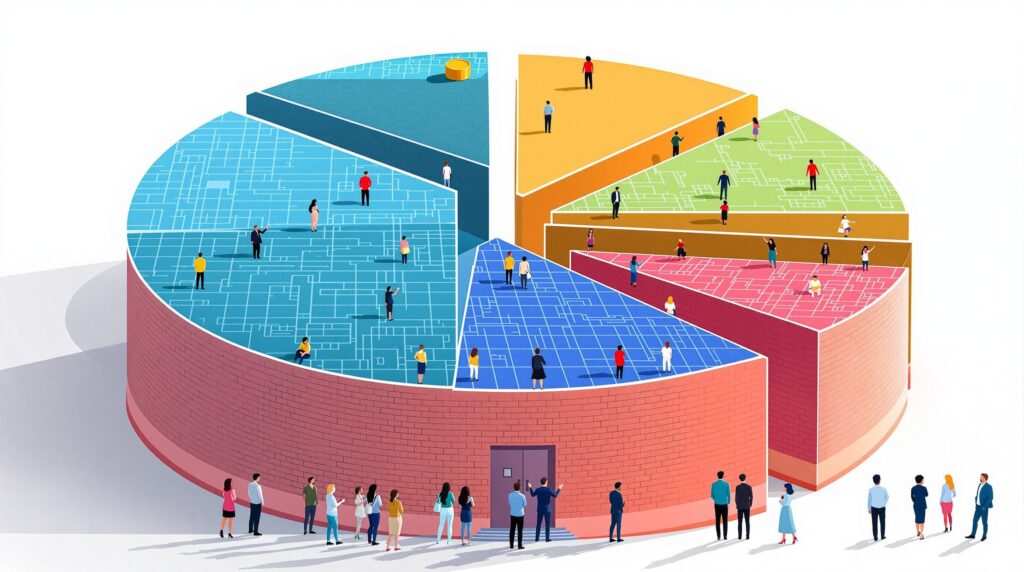[rev_slider alias=”slider-1″][/rev_slider]
The Significance of Layer 1 Blockchains
Layer 1 blockchains form the bedrock of the entire blockchain ecosystem, much like the foundation of a skyscraper. When you think about the online transactions and digital contracts we execute daily, these seemingly simple processes rely on incredibly complex infrastructures built by Layer 1 blockchains. Prime examples of Layer 1 blockchains include Bitcoin and Ethereum. They are like the original footprints in the blockchain universe, providing foundational layers that allow a multitude of digital applications to exist and flourish.
Layer 1 blockchains are the principal networks upon which all other blockchain functions operate, providing the critical infrastructure for executing smart contracts and deploying decentralized applications (dApps).
These blockchains are known for their ability to handle the entire range of on-chain functions. They are responsible for processing and validating transactions, executing smart contracts, and supporting decentralized applications (dApps). Imagine you want to send a friend a smart contract that automatically triggers a payment once a certain condition is met. It’s the infrastructure of a Layer 1 blockchain that makes this possible, ensuring reliability and security.
Capabilities of Layer 1 Blockchains
- Decentralization: Layer 1 blockchains operate on a decentralized network of nodes, ensuring no single point of failure and enhancing security.
- Consensus Mechanisms: These blockchains utilize different consensus mechanisms like Proof of Work (PoW) and Proof of Stake (PoS) to verify and validate transactions.
- Smart Contracts: They enable self-executing contracts with terms encoded directly into the blockchain, eliminating the need for intermediaries.
- dApp Support: Provide the framework for developers to build and run applications without downtime.
Layer 1 blockchains employ various consensus mechanisms to validate transactions and secure networks. For instance, Bitcoin uses the Proof of Work (PoW) method, which, while robust, can be energy-intensive. On the other hand, Ethereum has transitioned to Proof of Stake (PoS), which is more energy-efficient and promotes environmental sustainability.
Despite their foundational strength, these systems are not without challenges. Scalability remains a significant concern, as Layer 1 blockchains sometimes struggle with speed and efficiency, especially during high traffic. However, solutions like Layer 2 blockchains aim to tackle these issues by enhancing the performance of their predecessors.
Ethereum’s transition to Proof of Stake is a pivotal step in addressing scalability and sustainability, ensuring it meets the increasing demands of global users.
The ultimate goal is to create a transaction environment that is not only fast and reliable but also secure and accessible to all. Layer 1 blockchains like Ethereum and Bitcoin are continually evolving to meet these goals. As they do, they lay the groundwork for a myriad of future possibilities, from secure digital identity verification to seamless cross-border transactions.
Top Layer 1 Blockchains for Smart Contracts
When considering the top Layer 1 blockchains for smart contracts, it’s essential to identify those solutions that not only provide strong functionalities but also cater to a vast developer community. In this section, we’ll evaluate the leading Layer 1 blockchains—Ethereum, Binance Smart Chain, and Solana—each renowned for their ability to support smart contracts with unique strengths in transaction speed and cost-effectiveness.
Ethereum’s Dominance in Smart Contracts
As one of the pioneering platforms in blockchain technology, Ethereum has established itself as the default choice for developers across the globe. But what makes Ethereum so special in the realm of smart contract and dApp development?
Ethereum is a decentralized platform enabling smart contracts, which are applications that run exactly as programmed without any possibility of downtime, censorship, fraud, or third-party interference.
Ethereum boosts its appeal by continuously evolving. Its upgrade to Ethereum 2.0 is a testament to this, focusing on enhancing scalability and security. By transitioning from a Proof of Work (PoW) consensus mechanism to a Proof of Stake (PoS) system, Ethereum aims to increase transaction throughput significantly. This shift is critical for supporting its expansive network while maintaining environmental sustainability.
Another feather in Ethereum’s cap is its robust developer community. This community has created a vast array of decentralized applications (dApps), ranging from finance to gaming. Have you ever thought about how robust the community support can contribute to a platform’s success? Well, in Ethereum’s case, it’s massive community support provides a backbone for innovative development and problem-solving.
Binance Smart Chain’s Competitive Edge
While Ethereum is often the most talked about, Binance Smart Chain (BSC) emerges as a powerful contender. Why is Binance Smart Chain gaining such traction? The answer lies in its efficiency and rapid transaction processing capabilities, which are crucial aspects for many developers.
Binance Smart Chain offers a high-performance blockchain environment, designed to support scalable and decentralized applications effortlessly.
BSC leverages a dual-chain architecture allowing users the advantage of both high transaction throughput on BSC and the flexibility of leveraging Binance Chain for other functions. One crucial factor is its affordability. The cost per transaction on BSC is significantly lower than its counterparts. This feature is particularly attractive in regions like Africa, where maintaining low transaction costs is vital for broader financial accessibility.
In addition to technical prowess, Binance actively fosters a thriving developer environment with frequent hackathons and ongoing developer support. The ease of integrating cross-chain compatibility heightens BSC’s appeal, offering a seamless transition for projects looking for cost-effective and scalable solutions.
Solana: Speed and Innovation
Solana is often lauded for its exceptional speed and innovation. But what sets Solana apart as a formidable Layer 1 blockchain in this category? The platform’s claim to fame is its ability to process transactions at lightning speeds without compromising its decentralization tenet.
Solana’s platform executes more than 50,000 transactions per second, fueled by its unique Proof of History consensus, redefining the standards of blockchain speeds.
Transaction costs on Solana are among the lowest in the market, a critical factor for large-scale dApp deployment. Such affordability makes Solana an attractive choice for developers seeking to innovate without breaking the bank. Its infrastructure supports a wide range of decentralized finance (DeFi) projects, achieving a delicate balance between speed, security, and cost-effectiveness.
Moreover, Solana’s modular architecture allows seamless innovations and upgrades without disrupting the existing network—a feature particularly important as blockchain technology continues to evolve. For industrial applications where speed and scalability are paramount, Solana stands as a promising solution.
“Your Voice, Our Mission” – we champion blockchain solutions that empower innovation and enhance accessibility.
[rev_slider alias=”text-call-cta”][/rev_slider]
Integrating Layer 2 Solutions for Enhanced Performance
In the ever-evolving world of blockchain technology, there’s a compelling need to build systems that can handle massive amounts of users while ensuring efficiency and cost-effectiveness. This is where Layer 2 solutions come into play. If you’ve ever wondered how the likes of Polygon or Optimism manage to make transactions lightning-fast and affordable, you’re in the right place.
So, how exactly do these Layer 2 solutions enhance the performance of Layer 1 blockchains?
Layer 2 solutions are off-chain networks built on top of Layer 1 blockchains, designed to improve scalability and transaction speed while significantly reducing costs.
Addressing Scalability Challenges
Layer 1 blockchains like Ethereum have their drawbacks, particularly when dealing with high transaction volumes. As more users join the network, the number of transactions explodes, leading to network congestion. Picture driving during rush hour traffic; it’s slow and frustrating, right? That’s similar to what happens on a busy blockchain network.
- Solution – Layer 2 Protocols: By using Layer 2 protocols, these transactions can be processed off-chain before being added to the main blockchain, much like a carpool lane that speeds up the overall traffic flow.
- Examples: Solutions like Polygon and Optimism provide a framework to build efficient decentralized applications (dApps) that can handle high user volumes without the sluggishness or costs associated with a congested Layer 1 blockchain.
- Real-World Impact: Integrating Layer 2 solutions ensures that dApps function smoothly, which is vital for maintaining user engagement and satisfaction.
Cost-Effectiveness
It’s no secret that the Ethereum network can sometimes be expensive, with gas fees that might remind you of steep city tolls during peak times. However, Layer 2 solutions shine by significantly lowering these costs, making blockchain technology more accessible and equitable.
- Reduced Fees: By processing transactions off-chain, these solutions decrease the burden on the main network, effectively reducing the fees users must pay to get their transactions processed.
- Bridging Global Capital: With reduced costs, platforms like Jara are able to facilitate greater financial inclusion in regions like Africa, making digital finance accessible to millions.
Utilizing Jara’s Proprietary Layer 2 Blockchain
At the heart of Africa’s burgeoning tech landscape is the drive to innovate and improve infrastructures for digital assets. Jara stands as a cornerstone in this digital revolution with its proprietary Layer 2 blockchain, built on a Caldera base. It exemplifies how Layer 2 solutions work in practice, ensuring swift transactions and supporting the needs of both consumers and businesses.
- Caldera-Based Solution: By leveraging its Caldera-based framework, Jara’s blockchain promises high throughput and low latency—key ingredients for successful digital economies.
- Blockchain’s Role: This infrastructure is vital for large-scale projects like tokenizing the Lagos Airport, where fast and affordable transactions are non-negotiable.
In summary, integrating Layer 2 solutions merges innovation with necessity, creating a robust, user-friendly, and economically sound ecosystem for digital applications. Whether it’s streamlining operations or democratizing financial services, these enhancements are set to redefine the blockchain landscape. The harmonious integration of these technologies positions Africa’s digital asset economy for an exciting future.
Future Trends in Blockchain Technology for dApps
The world of blockchain technology is evolving rapidly, particularly when it comes to dApps—decentralized applications that offer a myriad of benefits over traditional software models. But what’s next for blockchain, and how will it impact the development of dApps in the future? Let’s dive into some of the anticipated trends that are expected to shape this exciting industry.
Innovations in Layer 1 and Layer 2 Blockchains
First, it’s crucial to differentiate between Layer 1 and Layer 2 blockchain solutions. Layer 1 blockchains are the foundational platforms, like Ethereum, that handle large volumes of transactions directly on their own ledgers. Meanwhile, Layer 2 blockchains sit atop these platforms, offering scalability solutions without overloading the main chain.
- Scalability Enhancements: Layer 2 blockchains such as Lightning Network provide vital improvements in scalability. By processing transactions off-chain and only settling in bulk on the main chain, they significantly increase the number of transactions per second (TPS) while reducing congestion.
- Security Upgrades: Both layers are continually enhancing their security protocols. Enhanced cryptographic measures and sophisticated consensus algorithms are reducing vulnerabilities and increasing confidence among users.
- Interoperability Improvements: The future promises more robust interoperability between blockchains, enabling smoother interactions and transactions among different platforms. Solutions like Polkadot and Cosmos are at the forefront, offering cross-blockchain transactions that can boost global blockchain adoption.
Impact of DeFi on Blockchain Adoption
Decentralized Finance, or DeFi, represents a massive leap forward in how we think about finance and the use of blockchain technology. By removing intermediaries, DeFi platforms provide more accessible financial services to a broader audience, enabling peer-to-peer transactions and smart contract-based loans without traditional banking infrastructures.
How does DeFi influence blockchain adoption? DeFi significantly increases blockchain adoption by democratizing access to financial services, allowing anyone with an internet connection to participate in global finance.
- Decentralized Exchanges: These platforms allow users to trade cryptocurrencies directly without a central authority, leading to increased user sovereignty and reduced transaction costs.
- Lending Platforms: DeFi lending platforms enable users to borrow and lend cryptocurrencies seamlessly. They operate under smart contracts that automate the entire loan process, from agreement to repayment, minimizing the need for intermediaries.
- Stablecoins: By providing stability in volatility-prone environments, stablecoins are seen as a gateway for new users entering the blockchain space, enhancing trust and usability.
The Role of $JARA in Africa’s dApp Ecosystem
At the forefront of these trends in Africa stands Jara, a platform driving digital transformation across the continent. Jara’s ecosystem integrates advanced Layer 2 solutions to offer a user-friendly interface for its decentralized applications, particularly appealing to Africa’s rapidly growing mobile user base.
The $JARA token serves as a pivotal component within this ecosystem, facilitating transactions, powering smart contracts, and rewarding user participation. It embodies the blockchain revolution in financial inclusivity, a crucial factor for the success of dApps in Africa.
With initiatives like the $6 billion Lagos airport tokenization project and partnerships with financial giants, Jara is setting the stage for a new era of economic empowerment in Africa. This project not only catalyzes blockchain adoption but also demonstrates the potential of tokenized real-world assets on enhancing infrastructure development.
The future of blockchain for dApps holds immense potential, driven by technological advances and increasing user acceptance throughout Africa and beyond. As these trends unfold, platforms like Jara are poised to play an integral role in this dynamic landscape, fueling both innovation and accessibility.
[rev_slider alias=”schedule-consultation-btn”][/rev_slider]

What is the main difference between Layer 1 and Layer 2 blockchains?
Layer 1 blockchains, which include the likes of Bitcoin and Ethereum, operate as the primary base layer of the entire blockchain infrastructure, handling the main transactional and consensus processes. Layer 2 solutions like Polygon and Optimism are built on top of Layer 1 blockchains to improve scalability and efficiency by handling transactions off-chain, thereby reducing the load on the Layer 1 network.
How do smart contracts on Layer 1 blockchains differ?
Smart contracts on Layer 1 blockchains are self-executing contracts with the terms written directly into code. They run on the blockchain itself, providing high security and immutability. Ethereum, for example, is renowned for its versatility in smart contract capabilities, whereas other Layer 1 blockchains like Binance Smart Chain aim to offer faster transaction speeds.
Can Layer 1 blockchains support dApps without Layer 2 solutions?
Yes, Layer 1 blockchains can support decentralized applications (dApps), but their performance may be limited by scalability challenges, such as slower transaction processing and higher fees as the network grows. Integrating Layer 2 solutions can enhance this performance by offloading traffic from the main chain, helping manage growth and usage spikes more effectively.
What future advancements in Layer 1 blockchains can we expect?
Future advancements in Layer 1 blockchains involve improvements in scalability, security, and interoperability. Projects are focusing on upgrading consensus mechanisms, like Ethereum’s shift to proof-of-stake, and integrating more interoperability layers to enhance communication across different blockchain networks, ultimately creating a more robust infrastructure that supports the growing demand for decentralized applications.

Related Practice Areas
Explore additional areas we specialize in that complement our Layer 1 blockchain expertise.
Client Testimonials
At the forefront of our Layer 1 and Layer 2 blockchain solutions practice is a deep-seated commitment to client satisfaction. Each case is handled with utmost care, as echoed in the appreciative feedback from those we represent.

[rev_slider alias=”slider-3″][/rev_slider]
[rev_slider alias=”slider-6″][/rev_slider]
Explore the Future of Your Blockchain Journey with Jara
Your success in the blockchain space requires expertise, innovation, and a trusted partner. At Jara, we offer unparalleled insights and solutions for both Layer 1 and Layer 2 blockchain technologies. Download the Jara app for Android or iPhone today and join our rapidly growing network.
Bridging Global Capital to African Assets with Jara – Your Gateway to a Decentralized Future.
But don’t just take our word for it. Discover the recognition we’ve received:
| Recognition | Organization | Year | Details |
|---|---|---|---|
| Named among the “Top Blockchain Innovators Worldwide” | Blockchain Adoption Network | 2023 | View Award Details |
| Listed as a “Leading Fintech Company in Africa” | Fintech Leaders Coalition | 2023 | View Award Details |
| Highlighted in the “Top Layer 1 Blockchain Innovators” | CryptoTech Awards | 2023 | View Award Details |
| Featured in the “Best Emerging Markets Blockchain Firms” | Global Blockchain Index | 2023 | View Award Details |
| Recognized as part of the “Top Blockchain Solution Providers” | Blockchain Review Board | 2023 | View Award Details |
Stay ahead of blockchain trends and innovations with Jara. Your vision, empowered by our expertise. Visit our website at www.getjara.xyz or email us at [email protected] for more information.
Chinyere “Chi” Nnadi Bio
Founder and CEO, Jara | Blockchain Technology Specialist
Content Reviewed by Chi Nnadi and his Content Team. Chi is a pioneering entrepreneur committed to evolving Africa’s blockchain potential. Serving as the Founder and CEO of Jara, he leverages groundbreaking Layer-2 blockchain solutions to introduce enhanced liquidity to African assets, making them accessible globally. He is a pivotal force in uniting international investors with Africa’s burgeoning digital economy.
Our Content Review Process
Chi Nnadi along with Jara’s dedicated content team pledge to deliver exemplary material. Our rigorous content standards encompass accuracy, authoritative sourcing, and impartial assessments. Should you uncover any discrepancies, please inform us for immediate revision.
















